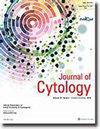USG引导细针抽吸细胞学结合免疫细胞化学诊断原发性恶性混合性苗勒管肿瘤:一项来自三级护理中心的三年研究
IF 1
4区 医学
Q4 MEDICAL LABORATORY TECHNOLOGY
引用次数: 0
摘要
目的与目的:探讨细针穿刺细胞学(FNAC)和免疫细胞化学在原发性恶性混合性苗勒管瘤(MMMT)诊断中的应用价值。材料与方法:在某三级医院进行了一项为期3年的回顾性研究,纳入了所有在超声引导下行盆腔肿块FNAC的妇科患者。观察与结果:324例中,05例(1.5%)为原发性恶性混合性苗勒管瘤。其中卵巢03例,子宫01例,双侧子宫及单侧附件01例。肿块的FNA涂片显示双期肿瘤的细胞形态学特征,呈细长多形性梭形细胞和分散的局灶性腺泡型,提示MMMT的可能性。免疫细胞化学结果显示波形蛋白和细胞角蛋白均呈阳性。随后的活检和免疫组织化学证实了诊断(没有任何组织病理学和细胞学差异)。结论:虽然文献中对MMMT的组织病理诊断有很多,但usg引导下的FNAC诊断却很少有报道。重点应放在仔细检查涂片中的小肉瘤成分。应用细胞阻滞和免疫细胞化学结合组织病理学检查,避免误诊。本文章由计算机程序翻译,如有差异,请以英文原文为准。
USG Guided Fine Needle Aspiration Cytology along with Immunocytochemistry to Diagnose Primary Malignant Mixed Mullerian Tumors: A Three-Year Study from a Tertiary Care Center
Aims and Objectives: To study the diagnostic utility of fine-needle aspiration cytology (FNAC) and immunocytochemistry in diagnosing primary malignant mixed Mullerian tumors (MMMT). Materials and Methods: A 3-year retrospective study carried out in a tertiary care hospital, which included all the gynecological patients who underwent USG-guided FNAC of their abdominopelvic masses. Observations and Results: Out of the 324 total cases, 05 (1.5%) were reported as primary malignant mixed Mullerian tumors. Out of these 05 cases, 03 were ovarian, 01 was uterine, and 01 involved both uterus and one-sided adnexa. The FNA smears from the masses revealed cytomorphological features of a biphasic neoplasm with elongated pleomorphic spindle cells and dispersed, focal attempted acinar pattern, thus indicating the possibility of MMMT. Immunocytochemistry was further carried out which showed both vimentin and cytokeratin positivity. The diagnosis was confirmed on subsequent biopsy and immunohistochemistry (without any histopathological-cytological discrepancy). Conclusion: Though the literature is replete in establishing a histo-pathological diagnosis of MMMT, the diagnosis on USG-guided FNAC has been rarely described. Emphasis should be made on the careful examination of small sarcomatous elements in smears. Utilization of cell block and immunocytochemistry with histopathological correlation should be done to avoid misdiagnosis.
求助全文
通过发布文献求助,成功后即可免费获取论文全文。
去求助
来源期刊

Journal of Cytology
MEDICAL LABORATORY TECHNOLOGY-
CiteScore
1.80
自引率
7.70%
发文量
34
审稿时长
46 weeks
期刊介绍:
The Journal of Cytology is the official Quarterly publication of the Indian Academy of Cytologists. It is in the 25th year of publication in the year 2008. The journal covers all aspects of diagnostic cytology, including fine needle aspiration cytology, gynecological and non-gynecological cytology. Articles on ancillary techniques, like cytochemistry, immunocytochemistry, electron microscopy, molecular cytopathology, as applied to cytological material are also welcome. The journal gives preference to clinically oriented studies over experimental and animal studies. The Journal would publish peer-reviewed original research papers, case reports, systematic reviews, meta-analysis, and debates.
 求助内容:
求助内容: 应助结果提醒方式:
应助结果提醒方式:


